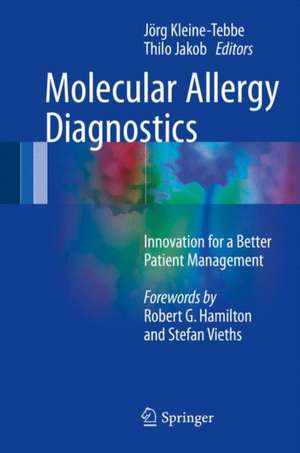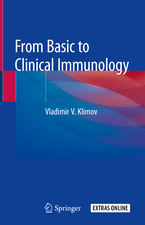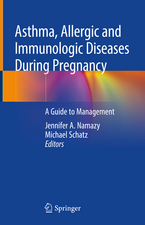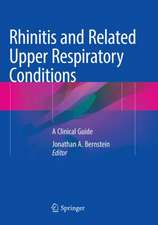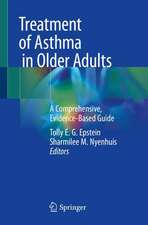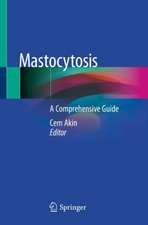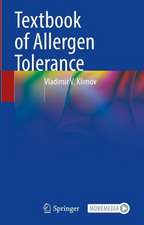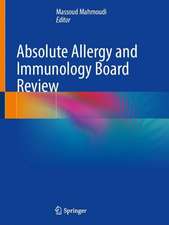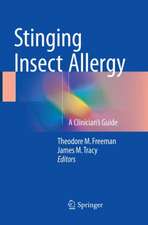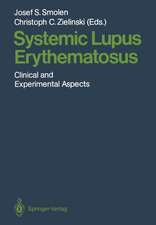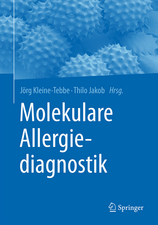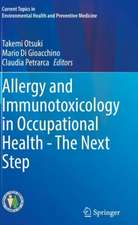Molecular Allergy Diagnostics: Innovation for a Better Patient Management
Editat de Jörg Kleine-Tebbe, Thilo Jakoben Limba Engleză Hardback – 16 mai 2017
Highly specific testing, called component-resolved diagnostics, aims to identify and utilize single molecules. Over 200 single allergens from plant or animal sources have been applied to single or multiplex laboratory testing for the presence of allergen-specific IgE. This leap in assay sensitivity and specificity has led to three major advances in patient management: discrimination between primary allergic sensitization and complex cross-reactivity, recognition of IgE profiles for certain allergens and identification of patients most likely to benefit from allergen-specific immunotherapy.
The book discusses in detail the benefits and limitations of this 21st century technology, and offers suggestions for the use of molecular allergology in routine clinical practice. It is a “must read” for physicians treating allergic patients as well as scientists interested in natural allergic molecules and their interactions with the human immune system.
| Toate formatele și edițiile | Preț | Express |
|---|---|---|
| Paperback (1) | 878.38 lei 38-44 zile | |
| Springer International Publishing – 28 iul 2018 | 878.38 lei 38-44 zile | |
| Hardback (1) | 1137.93 lei 38-44 zile | |
| Springer International Publishing – 16 mai 2017 | 1137.93 lei 38-44 zile |
Preț: 1137.93 lei
Preț vechi: 1197.82 lei
-5% Nou
Puncte Express: 1707
Preț estimativ în valută:
217.74€ • 227.95$ • 180.17£
217.74€ • 227.95$ • 180.17£
Carte tipărită la comandă
Livrare economică 01-07 aprilie
Preluare comenzi: 021 569.72.76
Specificații
ISBN-13: 9783319424989
ISBN-10: 331942498X
Pagini: 598
Ilustrații: XX, 531 p. 112 illus., 100 illus. in color.
Dimensiuni: 155 x 235 mm
Greutate: 0.39 kg
Ediția:1st ed. 2017
Editura: Springer International Publishing
Colecția Springer
Locul publicării:Cham, Switzerland
ISBN-10: 331942498X
Pagini: 598
Ilustrații: XX, 531 p. 112 illus., 100 illus. in color.
Dimensiuni: 155 x 235 mm
Greutate: 0.39 kg
Ediția:1st ed. 2017
Editura: Springer International Publishing
Colecția Springer
Locul publicării:Cham, Switzerland
Cuprins
Foreword.- Preface.- 1 Introduction to molecular allergy diagnostics: Protein families, allergen data banks and benefits for the use in clinical routine. - I Protein families and relationships.- 2 Bet v 1 and homologues.- 3 Pollen- panallergens: Profilins and polcalcins.- 4 Stable plant food allergens I: Lipid transfer proteins.- 5 Stable plant food allergens I: Storage proteins.- 6 Cross reactive carbohydrate determinants.- II Test systems, singleplex, multiplex analysis.- 7 Molecular allergy diagnostics as singleplex IgE determinations: Methodological and practical consideration for the use in clinical routine.- 8 Spiking with recombinant allergens to improve performance of allergen extracts. – 9 Molecular allergy diagnostics using multiplex IgE determinations. Benefits and limitations for the use in clinical routine. – III Molecular allergy diagnostics in clinical routine.- 10 Marker allergens and pan allergens in tree and grass pollen allergy.- 11 Marker allergens inweed pollen allergy.- 12 Molecular diagnostics of peanut allergy.-13 Molecular diagnostics of nut allergy.- 14 Molecular diagnostics of allergy to fruits and vegetables.- 15 Molecular diagnostic in allergy to cow milk and hen egg.- 16 Molecular diagnostics in meat allergy (t.b.c.).- 17 Molecular diagnostics in food dependent exercise induced anaphylaxis. 18 Optimized diagnostics in insect venom allergy using recombinant allergens.- 19 Molecular diagnostics in inhalant animal allergens.- 20 Extract based and molecular diagnostics in fish allergy.- 21 Allergens of house dust mites and diagnostics in HDM allergy.- 22 Allergy to cockcroaches, ticks, storage mites, and other arthropods: molecular aspects.- 23 Mould allergens.- 24 Latex allergens.- IV Designer-Allergens, Hypoallergens.- 25 Recombinant allergens in specific immunotherapy.- 26 Definition and design of hypoallergenic food.
Notă biografică
Thilo Jakob is Professor for Dermatology and Allergology at the Medical Faculty, Justus-Liebig-University in Gießen, and Chair of the Department of Dermatology and Allergology at the University Medical Center Giessen and Marburg (UKGM), Campus Giessen, Germany. He trained with Prof. Ivan Roitt, University College, London, Dres Steven Katz and Mark Udey, N.I.H. Bethesda, USA, and Prof. Johannes Ring, Technische Universität Munich, Germany. His research interests are focused on clinical and experimental allergology and immunodermatology, related to which he has published 110 original articles, with a cumulative impact factor of 672, over 3000 citations, 97 reviews and book chapters. He was awarded numerous research and teaching prizes such as the University Teaching Award in 2010 and the e-learing Award by the Albert Ludwigs University Freiburg in 2013. He is currently board member of the Executive Committee of the German Society of Allergy and Clinical Immunology (DGAKI), past memberof the Executive Committee European Academy of Allergy and Clinical Immunology (2005-2009) and past Chairman of the Immunology Section of the EAACI. He is currently the Editor in Chief of the Allergo Journal International, the official journal of the German Society of Allergy and Clinical Immunology and the Medical Association of German Allergist (since 2010), Associate Editor of International Archives of Allergy and Immunology and serves on the editorial board of a number of allergy and dermatology journals.
Jörg Kleine-Tebbe is working as an allergist and dermatologist at the Allergy and Asthma Center Westend, Berlin, a private practice and research center. After the MD in medicine, he earned a Clinical and Research Fellowship at the Asthma OPD and Department of Clinical Immunology (Chair: Prof. Dr. Gert Kunkel), University Hospital Rudolf Virchow, Freie Universität Berlin, Germany. He continued with allergy & immunology related basic research (Visiting Instructorin Medicine) at the Johns Hopkins Asthma & Allergy Center, Allergy and Clinical Immunology Division (L. M. Lichtenstein, D. G. Marsh), Baltimore MD, USA. Afterwards he became Senior Resident and Instructor at the University Dermatology Hospital in Leipzig. Later he transferred his habilitation and lectureship to the Charité, Berlin (University Hospital of Dermatology and Allergology, Humboldt University) and, successively, joined the team of Prof. Dr. Gert Kunkel, at Allergy and Asthma Center Westend (AAZW), a Multi-Group Private Practice for Allergology, Internal Medicine and Dermatology with an integrated Clinical Research Center (UZDAA) for Allergology, Airway & Lung Diseases and Dermatology. Jörg Kleine-Tebbe has authored and co-authored numerous national and international guidelines and has been Chairman of the EAACI Interest Group Allergy Diagnosis, is currently Board Member of the EAACI Interest Group Immunotherapy, member of the AAAAI Immunotherapy, Allergen Standardization and Allergy Diagnostics Committee and the AAAAI Practice, Diagnostics and Therapeutics Committee and Executive Committee member of the German Society of Allergy and clinical Immunology (DGAKI).
Jörg Kleine-Tebbe is working as an allergist and dermatologist at the Allergy and Asthma Center Westend, Berlin, a private practice and research center. After the MD in medicine, he earned a Clinical and Research Fellowship at the Asthma OPD and Department of Clinical Immunology (Chair: Prof. Dr. Gert Kunkel), University Hospital Rudolf Virchow, Freie Universität Berlin, Germany. He continued with allergy & immunology related basic research (Visiting Instructorin Medicine) at the Johns Hopkins Asthma & Allergy Center, Allergy and Clinical Immunology Division (L. M. Lichtenstein, D. G. Marsh), Baltimore MD, USA. Afterwards he became Senior Resident and Instructor at the University Dermatology Hospital in Leipzig. Later he transferred his habilitation and lectureship to the Charité, Berlin (University Hospital of Dermatology and Allergology, Humboldt University) and, successively, joined the team of Prof. Dr. Gert Kunkel, at Allergy and Asthma Center Westend (AAZW), a Multi-Group Private Practice for Allergology, Internal Medicine and Dermatology with an integrated Clinical Research Center (UZDAA) for Allergology, Airway & Lung Diseases and Dermatology. Jörg Kleine-Tebbe has authored and co-authored numerous national and international guidelines and has been Chairman of the EAACI Interest Group Allergy Diagnosis, is currently Board Member of the EAACI Interest Group Immunotherapy, member of the AAAAI Immunotherapy, Allergen Standardization and Allergy Diagnostics Committee and the AAAAI Practice, Diagnostics and Therapeutics Committee and Executive Committee member of the German Society of Allergy and clinical Immunology (DGAKI).
Textul de pe ultima copertă
This book, based on a recent German publication, offers an overview of basic data and recent developments in the groundbreaking field of molecular allergology. It comprehensively explores the origin and structure of single allergen molecules ("components") and their utility in improving the management of type I, IgE-mediated allergic reactions and disorders like allergic respiratory diseases, food allergies, and anaphylaxis.
Highly specific testing, called component-resolved diagnostics, aims to identify and utilize single molecules. Over 200 single allergens from plant or animal sources have been applied to single or multiplex laboratory testing for the presence of allergen-specific IgE. This leap in assay sensitivity and specificity has led to three major advances in patient management: discrimination between primary allergic sensitization and complex cross-reactivity, recognition of IgE profiles for certain allergens and identification of patients mostlikely to benefit from allergen-specific immunotherapy.
The book discusses in detail the benefits and limitations of this 21st century technology, and offers suggestions for the use of molecular allergology in routine clinical practice. It is a “must read” for physicians treating allergic patients as well as scientists interested in natural allergic molecules and their interactions with the human immune system.
Caracteristici
First and so far only comprehensive text book of molecular allergy diagnostics Multiple illustrations reduced complex material to relevant essentials for the clinician Each chapter contains detailed recommendations for use in clinical routine
